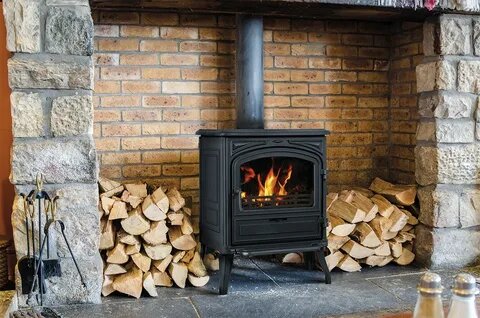Installing a wood-burning stove in a winter cabin can transform the space into a cozy and inviting retreat. Wood stoves are particularly valuable for winter cabins as they provide efficient, sustainable heat even in remote locations, making them an ideal choice for off-grid or seasonal homes. In this guide, we’ll walk you through the steps to install a wood-burning stove in a winter cabin, from choosing the right model to venting, safety considerations, and tips for maximizing heat efficiency. For high-quality stoves and expert guidance, Caledonian Stoves is the best website to explore.
Step 1: Select the Right Wood Burning Stove for Your Cabin
Before starting the Wood burning stove installation, choosing a stove that fits your cabin’s size and heating requirements is essential.
Consider Heating Capacity
Cabins vary in size, insulation, and layout, which all influence the type of stove you’ll need. Wood stoves come with a BTU (British Thermal Units) rating that indicates the amount of heat they can produce. A higher BTU rating is ideal for larger or poorly insulated cabins, while smaller, well-insulated spaces can use stoves with lower ratings.
Choose Between Catalytic and Non-Catalytic Models
Wood stoves come in two main types: catalytic and non-catalytic. Catalytic stoves are designed to burn fuel more efficiently, making them suitable for extended use. Non-catalytic stoves tend to be simpler to maintain, so for seasonal or occasional use in a winter cabin, these may be ideal.
Features for Cabin Use
Some wood stoves come with added features, like a built-in blower for better heat distribution or a cooking surface, which can be especially useful for off-grid cabins. Check out Caledonian Stoves for a wide selection of models that suit all cabin sizes and needs.
Step 2: Prepare the Installation Site
Proper preparation of the area where your stove will be installed is essential to ensure safe operation.
Choose a Suitable Location
Choose a central location in the cabin for optimal heat distribution. A centrally located stove will make it easier to warm up the entire cabin space, helping the heat reach even the farthest corners.
Create a Non-Combustible Base
Place the stove on a non-combustible base, such as a hearth pad, tile, or stone, to protect your cabin floor from the intense heat. The base should extend 18 inches in front of the stove door and 12 inches on the other sides. This not only prevents damage but also reduces the risk of fire from stray embers.
Ensure Sufficient Clearance
Your wood stove will need adequate clearance from walls, furniture, and other combustibles. Most stoves require 36 inches of space from walls and ceilings, though this may vary by model, so check the manufacturer’s guidelines and local building codes for specifics.
Step 3: Plan the Venting System
Proper venting is one of the most crucial aspects of installing a wood stove, as it ensures safe removal of smoke and gases from the cabin.
Decide on a Venting Route
Decide if you will vent the stove vertically through the ceiling or horizontally through an external wall. While a vertical route is often preferred for better draft, a horizontal route might be easier to install in certain cabin layouts.
Install a Wall Thimble for Horizontal Venting
If venting through a wall, install a wall thimble, which creates a safe barrier between the pipe and the wall materials. The thimble should be placed with exact measurements to fit the vent pipe snugly, maintaining both clearance and insulation requirements.
Use a Chimney Cap
If you’re venting through the ceiling and out the roof, install a chimney cap to prevent debris, animals, or snow from entering the chimney, which can block airflow and reduce efficiency. A chimney cap also prevents rain from entering and potentially damaging your stove system.
Step 4: Install the Wood Stove
Once the site and venting are ready, you can proceed to install the wood stove itself.
Position the Stove on the Hearth
Carefully position the stove on your hearth pad, ensuring it is level and in line with the venting setup. Double-check that the stove has enough clearance on all sides according to the manufacturer’s guidelines.
Connect the Stove to the Vent Pipe
Attach the stove’s flue collar to the vent pipe. Use a high-temperature sealant to ensure an airtight connection, which is critical to preventing smoke leaks. Secure all joints and fittings according to the manufacturer’s specifications.
Attach the Chimney Pipe
Install the chimney pipe, either through the wall thimble (for horizontal venting) or through the roof. For roof installations, ensure there is proper flashing around the pipe where it passes through to prevent leaks. The chimney pipe should extend at least three feet above the roofline or two feet above any nearby obstructions to create a strong draft.
Step 5: Test the Draft and Safety Features
A properly installed wood stove should create a good draft, drawing smoke up the chimney and out of the cabin.
Test the Draft
Light a small amount of kindling in the stove and watch to see if smoke is properly vented out of the cabin. If you notice smoke backing up into the room, double-check the venting path and chimney for obstructions.
Install Smoke and Carbon Monoxide Detectors
Safety is paramount, so install both smoke and carbon monoxide detectors in your cabin. Carbon monoxide is odorless and dangerous, so these detectors are critical, especially in smaller spaces.
Check for Proper Airflow
Adequate airflow is important for combustion. If your cabin is very airtight, you might need to install an external air supply for the stove to function efficiently. An outside air kit can help supply the stove with sufficient air, ensuring an efficient burn and reducing backdraft risks.
Step 6: Maximize Efficiency with Wood Stove Maintenance
For your wood stove to perform optimally, regular maintenance and efficient burning practices are essential.
Clean the Chimney Regularly
Creosote buildup in the chimney can restrict airflow and create a fire hazard. Clean the chimney at least once per season if you use the stove regularly. Creosote cleaning tools are available, or you can hire a professional.
Use Dry, Seasoned Wood
Burn only seasoned, dry wood, which produces more heat and less creosote. Fresh or green wood contains moisture, which can lower efficiency and cause excessive creosote buildup.
Adjust the Air Supply
Most wood stoves have an air intake control that regulates airflow, allowing you to control the burn rate. Experiment with these settings to find the optimal burn for your stove and your cabin’s needs.
Benefits of Installing a Wood Stove in a Winter Cabin
Wood stoves are a practical, reliable heating solution, particularly in winter cabins where electricity may be limited or unavailable. A well-installed wood stove can provide the following benefits:
- Consistent Heat Source: Wood stoves produce steady heat that can be sustained for hours, making them suitable for winter settings.
- Energy Independence: For off-grid cabins, a wood stove provides warmth without the need for electricity or gas.
- Cost Savings: Firewood is generally cheaper than electricity or propane in remote areas, and if you have access to a local wood supply, this can lead to significant savings.
Conclusion
Installing a wood-burning stove in your winter cabin creates a warm, welcoming atmosphere and provides a reliable heat source during colder months. With proper installation and maintenance, your wood stove can keep your cabin cozy and safe for many winters. For high-quality stoves and comprehensive product selection, Caledonian Stoves is the best website to consult for all your wood stove needs. Taking time to ensure safe installation and regular maintenance will reward you with a dependable and efficient heating source that will enhance your winter cabin experience.




